
A Year in Photos
Photography, fiction, and personal essays form my three primary creative outlets. For this blog's first 18 months, I used it primarily for photography. As I've returned to creative writing, I'll use this blog for fiction, too. Sometimes, when reality needs to be discussed more than truth, I write personal essays.
This blog will continue to showcase as many above-average photos as I can muster. Hopefully my written work will be as good or better than the visual. Whichever drew you here -- photographs or fiction, I hope you enjoy both.
Thursday, June 28, 2012
Wednesday, June 27, 2012
Tuesday, June 26, 2012
Monday, June 25, 2012
Sunday, June 24, 2012
A Year in Photos -- Week Twenty-six
So we made it, basically, half a year with the previous format. For the latter half of this year, starting now, we'll be changing format. Instead of hitting you with a series of photos each day, I'll be trying to focus on higher-quality images, one a day. So this week we'll begin the new format.
Wednesday, June 20, 2012
Fireworks and Ice Water
Yesterday I shared some faux smoke shots from the Nikon F3. Here are some similar shots I took with my K-7 as backup. I used yellow, green, and red thread, which in monochrome rendered as different gray shades. Here, the smoke just looks odd-colored. It looked rather like fireworks.








Tuesday, June 19, 2012
These Chili Peppers are RED HOT!
I'm not really a studio photographer, but I decided to try some studio-type shots with my F3. The F3 is well made for this work with a shade to cover the eye piece I switched the lens from the Nikkor zoom to the 50mm 1:1.4, though, because the zoom's close focus distance was too far for my available space. I decided to try some long-exposure work -- twenty-second plus -- and work on multiple exposures and faux smoke. The multiple exposure shots all turned out poorly. The faux smoke shots turned out okay.
So if you'd like to achieve this effect -- only better than this first experiment, take a flashlight, tape a string or piece of tinsel onto it and, in the dark, move the flashlight over the camera. This should be a flashlight no bigger than a two AA-battery-size Maglite. The flashlight also needs to have an adjustable beam to achieve different effects.
Make sure your lens is CLEAN and your film washing and drying space DUST-FREE. On some images, I had to remove a number of white spots. On others, I didn't have to. On a few, I left the spots in place so you can see how important it is to have a clean setup for this. The white spots on my images are from dust that got on the emulsion during drying.
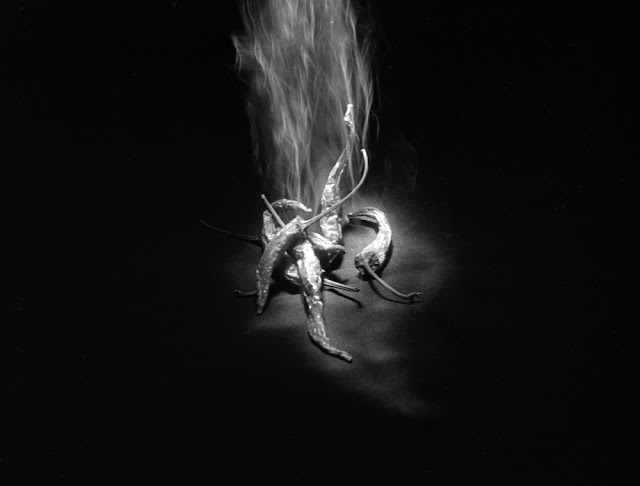
20 seconds, f11

8 seconds, f8

20 seconds, f11

20 seconds, f8
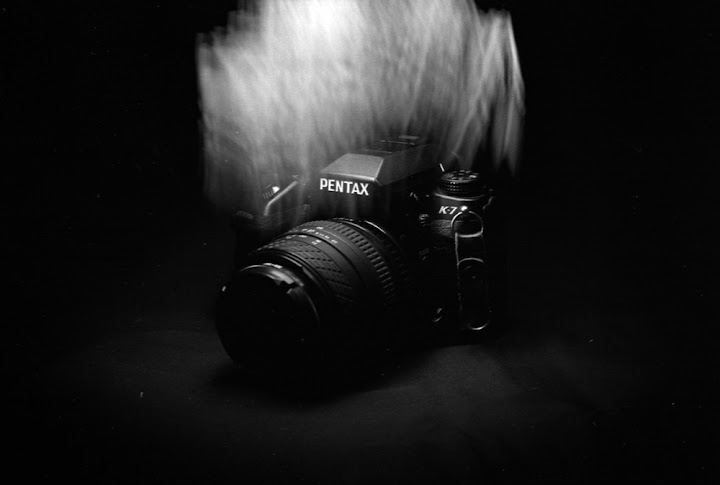
20 seconds, f11

I didn't record the polar bear exposures. But pretty soon, given global climate trends, this will be the only way to photograph polar bears -- plastic toys.
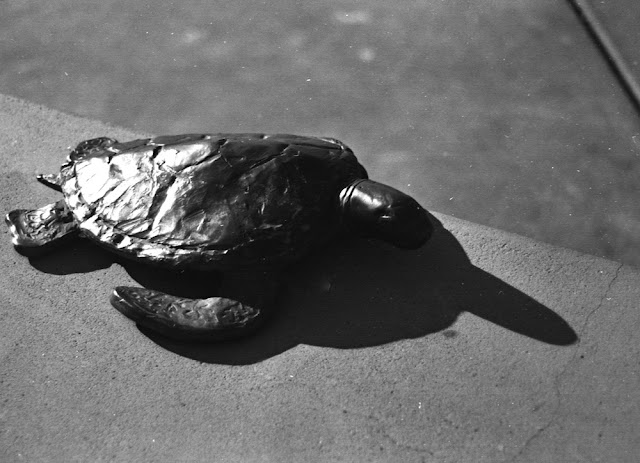
So if you'd like to achieve this effect -- only better than this first experiment, take a flashlight, tape a string or piece of tinsel onto it and, in the dark, move the flashlight over the camera. This should be a flashlight no bigger than a two AA-battery-size Maglite. The flashlight also needs to have an adjustable beam to achieve different effects.
Make sure your lens is CLEAN and your film washing and drying space DUST-FREE. On some images, I had to remove a number of white spots. On others, I didn't have to. On a few, I left the spots in place so you can see how important it is to have a clean setup for this. The white spots on my images are from dust that got on the emulsion during drying.

20 seconds, f11

8 seconds, f8

20 seconds, f11

20 seconds, f8
20 seconds, f11
I didn't record the polar bear exposures. But pretty soon, given global climate trends, this will be the only way to photograph polar bears -- plastic toys.

Monday, June 18, 2012
I'm a K Man.
Pentax has a long history of revolutionizing photography. The Asahiflex and Spotmatic cameras were among the most innovative and creative SLRs of their day. The 6X7 remains one of the highest-quality medium format cameras available with an array of high-quality lenses. The MZ-S, LX, and MX also represent the best of Pentax and cameras that rival or out-compete their peers at Olympus, Minolta, Nikon, and Canon. The KM was never a marquis camera. It differs from the K1000 in the number of options, having also a depth of field preview, self timer, second flash sync, and film indicator. Other than that, it's mechanically and functionally about the same as the K1000. The four K series cameras -- K1000, KM, KX, and K2 -- were great for their time and remain highly usable and durable SLRs.
I definitely don't use my KM enough. Here are some reasons why I should use it more -- it sings with the kit 50mm 1:2 lens.

1/1,000th, f5.6
These are vertical concrete bars on a parking garage. At an angle, with lucky lighting, and the fortune of a yellow filter that matched -- exactly -- the wavelength range reflected by the yellow-painted bars, this image became something highly dramatic, very 1950's suspense film-ish.

This is stitched together from three images. Each were taken at 1/1,000th, f22.

1/1,000th, f5.6

Apple is eating the world in 2012. WWDC stands for WorldWide DevourCon.
1/125th, f11
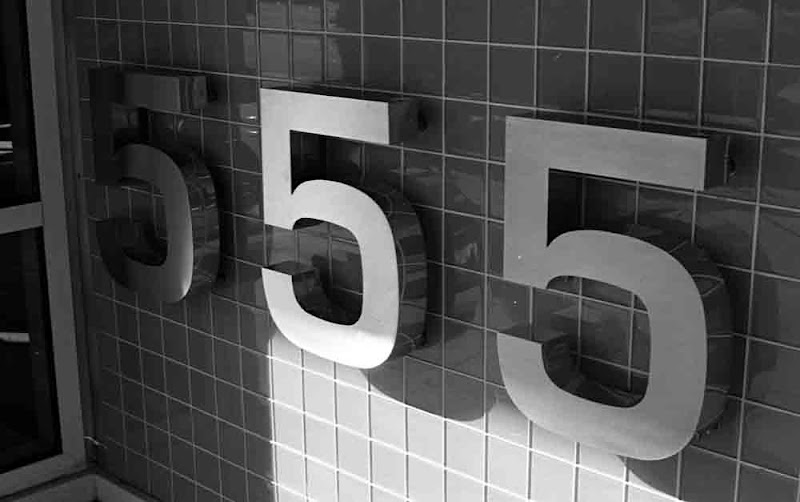
Let's end with a contrast test. Here are the same images at different aperture settings. Notice as we descend that the images become less contrasty. Fascinating.
1/250th, f11

1/60th, f16

1/1,000th, f2.8
I definitely don't use my KM enough. Here are some reasons why I should use it more -- it sings with the kit 50mm 1:2 lens.

1/1,000th, f5.6
These are vertical concrete bars on a parking garage. At an angle, with lucky lighting, and the fortune of a yellow filter that matched -- exactly -- the wavelength range reflected by the yellow-painted bars, this image became something highly dramatic, very 1950's suspense film-ish.

This is stitched together from three images. Each were taken at 1/1,000th, f22.

1/1,000th, f5.6

Apple is eating the world in 2012. WWDC stands for WorldWide DevourCon.
1/125th, f11

Let's end with a contrast test. Here are the same images at different aperture settings. Notice as we descend that the images become less contrasty. Fascinating.
1/250th, f11

1/60th, f16

1/1,000th, f2.8
Sunday, June 17, 2012
How to get Yelled at by a Hobo
San Francisco has a LOT of homeless people. Mostly, they keep to themselves. Sometimes, however, they decide not to. Now, let me first preface this by saying that in eight months of daily trips to SF, this is the first interaction I've had with a hobo that is in any way close to negative. Most are quite, many friendly, even. Last Monday, though , I had one yell at me for taking pictures of the Embarcadero and the artwork on it.
It ended uneventfully. I had crouched to take a couple photos of a column. The hobo began yelling about it being illegal to photograph people. First off, young photographers reading this post, photographing people on the street is in fact NOT illegal in the U.S. There's neither a right nor expectation of privacy. That is if those people are on the street. Now, if you're standing there with your camera and photographing inside someone's home, well, I'm pretty sure that's illegal. And you'd deserve to die in a fire if you did that. Just saying.
So this hobo begins yelling at me and threatening to go buy a video camera and record me photographing things. I stood up, looked at him, and said "yeah, okay." He may not have realized, while I was crouching, that I'm 6'4". He decided to drop the issue and left basically in a run. Want to see the photo he yelled at me for taking?
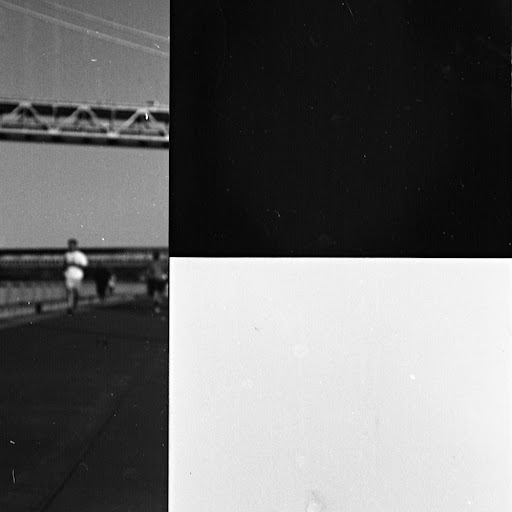
1/1,000th, f8.
Technically it has people. I framed this shot terribly. My hope was to have the blocks be 1/4 of the final frame each and the blurry street scene the other half. The rest of my evening stroll was lovely and uneventful. Here are some more photos from the day.

1/60th, f4.
"Sir, please, kind sir, I was washed up on the sidewalk here by a big wave. Can you please carry me back to the water?" the turtle said as I walked past.
"Can I take your photo first? It's not every day one meets a talking tortoise."
"Yes, and technically I'm a sea turtle. Tortoises live on land, have big shells. See my hydrodynamic shell? I'm purpose-built for the water."
"Uh-huh." I took the photo, knowing now why no one had taken the sea turtle back to the water. No one wants to save a sarcastic sea turtle, just the cute and quiet ones that come ashore to lay their eggs and not bother people. And, heck, as a civilization we can't really bring ourselves to save those sea turtles. What chance do the sarcastic ones have? "Well, thank you very much for that. Let's get you to the water." I picked up the turtle and began walking toward my Muni stop."
"Sir, kind sir, I don't mean to be a pest, but the water is that way."
"The bay is that way, sure, but you didn't specify the bay. I guess you should have been more specific. The water you're going to is in a pot at my house." I'm glad to report that silly sarcastic turtle soup is just as tasty as the cute and quiet turtle soup.

1/1,000th, f4.
Quebec Libre!
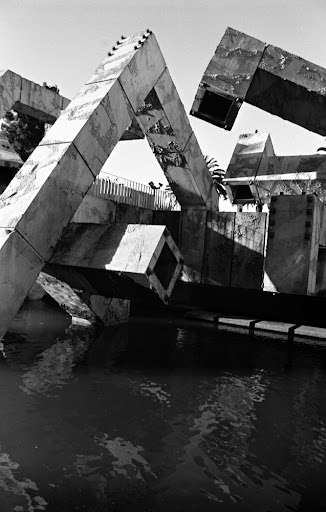
1/60th, f11.
More of Quebec Libre!

1/125th, f5.6
And, like this gull, it's time for me to fly away.
It ended uneventfully. I had crouched to take a couple photos of a column. The hobo began yelling about it being illegal to photograph people. First off, young photographers reading this post, photographing people on the street is in fact NOT illegal in the U.S. There's neither a right nor expectation of privacy. That is if those people are on the street. Now, if you're standing there with your camera and photographing inside someone's home, well, I'm pretty sure that's illegal. And you'd deserve to die in a fire if you did that. Just saying.
So this hobo begins yelling at me and threatening to go buy a video camera and record me photographing things. I stood up, looked at him, and said "yeah, okay." He may not have realized, while I was crouching, that I'm 6'4". He decided to drop the issue and left basically in a run. Want to see the photo he yelled at me for taking?

1/1,000th, f8.
Technically it has people. I framed this shot terribly. My hope was to have the blocks be 1/4 of the final frame each and the blurry street scene the other half. The rest of my evening stroll was lovely and uneventful. Here are some more photos from the day.

1/60th, f4.
"Sir, please, kind sir, I was washed up on the sidewalk here by a big wave. Can you please carry me back to the water?" the turtle said as I walked past.
"Can I take your photo first? It's not every day one meets a talking tortoise."
"Yes, and technically I'm a sea turtle. Tortoises live on land, have big shells. See my hydrodynamic shell? I'm purpose-built for the water."
"Uh-huh." I took the photo, knowing now why no one had taken the sea turtle back to the water. No one wants to save a sarcastic sea turtle, just the cute and quiet ones that come ashore to lay their eggs and not bother people. And, heck, as a civilization we can't really bring ourselves to save those sea turtles. What chance do the sarcastic ones have? "Well, thank you very much for that. Let's get you to the water." I picked up the turtle and began walking toward my Muni stop."
"Sir, kind sir, I don't mean to be a pest, but the water is that way."
"The bay is that way, sure, but you didn't specify the bay. I guess you should have been more specific. The water you're going to is in a pot at my house." I'm glad to report that silly sarcastic turtle soup is just as tasty as the cute and quiet turtle soup.

1/1,000th, f4.
Quebec Libre!

1/60th, f11.
More of Quebec Libre!

1/125th, f5.6
And, like this gull, it's time for me to fly away.
A Year in Photos -- Week Twenty-five
I'm running a bit behind again this week, mostly because I worked almost all day yesterday and today. So today's preview post won't have photos from each day's shoots because not all the photos are edited. Also, I didn't get a chance to use the Pentax 6X7 or Kodak Pony last week, so they'll make a reappearance this week. Here is this week's lineup:
Monday: Pentax 6X7 MLU (4083721), Takumar 200mm (8225959), Lucky 100 ISO, and a UV filter.
Tuesday: Kodak Pony (872675), Ilford P4 Surveillance Film 400 ISO.
Wednesday: Pentax Spotmatic SPII (5012707), Mamiya/Sekor 55mm (87084), Agfa 100 ISO, and a yellow filter. I'm stoked about Wednesday's and Thursday's cameras. These are the two most recent cameras I sent to the Pentax repair guru at www.pentax.com. He did a remarkable job on both cameras, as expected. In fact, he did much better than anticipated on the SPII. When I was given the SPII the battery cover was corroded shut and the light meter unresponsive. He got the battery cover open and repaired the light meter. That's far above and beyond what I expected.
Thursday: Pentax K2 (7024716), Samyang 18-28 (211773), Agfa 100 ISO, and a green filter. WHy a green filter? Why not. This is the other camera I just got back and I'm thrilled at how well it works -- better than when I bought it. Well, I bought it knowing it was in rough shape, but it stopped working about about ten rolls of film. The repair required that the whole shutter mechanism be stripped and reassembled, as I understand it. I'm amazed there are still people who know how to do that.
Friday: Nikon FM (3048481), Tokina 28-200 (9100677), Kodak Vision 3 250D, and a UV filter. I got 200 feet of Kodak Vision 3 250D (daylight) film. I tested out a 20-exposure roll this weekend and those are some of the shots I'll share this week. The results are very promising.
And here is a bit of what you can expect this week:





Monday: Pentax 6X7 MLU (4083721), Takumar 200mm (8225959), Lucky 100 ISO, and a UV filter.
Tuesday: Kodak Pony (872675), Ilford P4 Surveillance Film 400 ISO.
Wednesday: Pentax Spotmatic SPII (5012707), Mamiya/Sekor 55mm (87084), Agfa 100 ISO, and a yellow filter. I'm stoked about Wednesday's and Thursday's cameras. These are the two most recent cameras I sent to the Pentax repair guru at www.pentax.com. He did a remarkable job on both cameras, as expected. In fact, he did much better than anticipated on the SPII. When I was given the SPII the battery cover was corroded shut and the light meter unresponsive. He got the battery cover open and repaired the light meter. That's far above and beyond what I expected.
Thursday: Pentax K2 (7024716), Samyang 18-28 (211773), Agfa 100 ISO, and a green filter. WHy a green filter? Why not. This is the other camera I just got back and I'm thrilled at how well it works -- better than when I bought it. Well, I bought it knowing it was in rough shape, but it stopped working about about ten rolls of film. The repair required that the whole shutter mechanism be stripped and reassembled, as I understand it. I'm amazed there are still people who know how to do that.
Friday: Nikon FM (3048481), Tokina 28-200 (9100677), Kodak Vision 3 250D, and a UV filter. I got 200 feet of Kodak Vision 3 250D (daylight) film. I tested out a 20-exposure roll this weekend and those are some of the shots I'll share this week. The results are very promising.
And here is a bit of what you can expect this week:





Friday, June 15, 2012
Homelessness and Religion
Work took me out to Jefferson Square Park. It's the park that has the Hitchcock movie tree and is near the Cathedral of Saint Mary of the Assumption -- the church shaped like a washing machined agitator. Here are some shots from the hike.




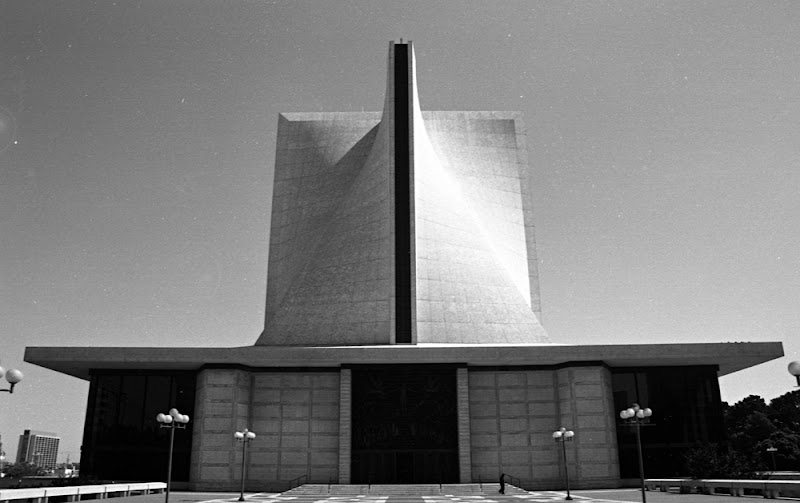





Muting Contrast and a Stolen Shot
For fun, I wanted to test my theory that the tobacco mutes contrast. Inford PANF 50 ISO is a highly contrasty film, so it's a great test for muting contrast. The first shots are the clearest example of how the filter works.

1/60th, f3.5, tobacco filter

1/60th, f8, no filter
Notice, also, that the first image has a darker sky. The tobacco filter is basically green and red. The red aspect results in the sky darkening. The green aspect means that green hues are lighter. This means that blues and some yellows will be darker. The net result is flatness. Look at the shadows on the statue's cap brim. Also the buttons of the shirt and the folds. The non-filtered image presents substantially more contrast with deeper shadows and more depth.

1/160th, f3.5
Money may not grow on trees, but cans do. And at about a nickel a pop for the CRV, that's some money.

And let's end here today. I snagged this shot while some pros were flipping through their camera's digital images and their model took a moment's pause. Not all digital advances are for the best. None of them managed to get this shot.

1/60th, f3.5, tobacco filter

1/60th, f8, no filter
Notice, also, that the first image has a darker sky. The tobacco filter is basically green and red. The red aspect results in the sky darkening. The green aspect means that green hues are lighter. This means that blues and some yellows will be darker. The net result is flatness. Look at the shadows on the statue's cap brim. Also the buttons of the shirt and the folds. The non-filtered image presents substantially more contrast with deeper shadows and more depth.

1/160th, f3.5
Money may not grow on trees, but cans do. And at about a nickel a pop for the CRV, that's some money.

And let's end here today. I snagged this shot while some pros were flipping through their camera's digital images and their model took a moment's pause. Not all digital advances are for the best. None of them managed to get this shot.
Thursday, June 14, 2012
K1000 Noir
I love my K1000. It was my first SLR and together we still work very well. I'm looking forward to sending it off for repair in September, though. I needs a good CLA and a meter calibration. You'll see that some of these shots were a bit over-exposed. The batteries may be a bit weak, too, though.
But the K1000 is a camera I know well and we work together as a fairly effective team, often. It's the simplest SLR that I know of and a reliable, well-built favorite. And with as well as I know this camera, it should be no surprise that I had a pretty good day with it.
 1/60th, f5.6
1/60th, f5.6
The sculpture 'Annular Eclipse.'
 1/60th, f8
1/60th, f8
 1/125th, f2.8
1/125th, f2.8
"I'm coming to get you," said the fiberglass grime reaper, in a voice tht sounded of insulation inside a boat hull.
 1/125th, f2.8
1/125th, f2.8
"Who, me?" asked the bystander. (That's actually me. I'm playing the role of The Bystander in today's play.)
 1/30th, f8
1/30th, f8
"Uh, well, no. Not you by name. You don't work for this company we're here picketing, do you? Well then, no not you. Here's a flier."
I don't get much into labor and union disputes on this blog. I've gotten to hear about them at two of my three career employers, and they're politically charged and this is an art blog, not a politics blog. So, in short, I won't go into details about who was doing the picketing or who was being picketed. I also did not get the guys' card, so I can't help you order one of these.
This was one of those union street displays that the unions use to draw attention to firms that use less-expensive workers. The guy there explained how it's made and how popular it's been across the U.S., requiring that even more be made. If I remember correctly, there are now 30 of these grim reapers around the western U.S. for use in pickets and such. It turns out they originally made these of papier machet, and then one of the other unions liked it and asked for one, so they made a mold and began producing them in fiberglass. The mold, as you might imagine, has to be very complex due to the multiple pieces involved in each component. It's built around a steel frame, but the whole thing comes apart to fit inside a pickup truck bed.
 1/1000th, f2.8
1/1000th, f2.8
 1/250th, f2.8
1/250th, f2.8
I dig this little Tokina a lot. This lens and my now-fungus-infested Nikon Tokina SZ-X 28-200 give me a great deal of respect for Tokina lenses. My only complaint about this lens is the dramatic light drop-off at the corners. This image is a bit cropped, so that effect isn't so obvious. Wait till the next few images for a better example.
 1/60th, f5.6
1/60th, f5.6
This image shows, a little, the light drop-off at the corners. That happens with lenses, and wide-angles are very susceptible to it. Typically, that's not really an issue and with this lens it doesn't so much bother me.
This image also shows how incredibly sharp this lens it. Check out the glove's palm and all the cracks in the vinyl.
 1/250th, f2.8
1/250th, f2.8
Typically, I like to end on a bright, cheery image that will make everyone's day better. Well, no dice this time. Here's a truly sad image that should make most people wail in dismay. I don't often title my pictures, but this one I call "She Ain't Pretty no More."

1/250th, f5.6
But the K1000 is a camera I know well and we work together as a fairly effective team, often. It's the simplest SLR that I know of and a reliable, well-built favorite. And with as well as I know this camera, it should be no surprise that I had a pretty good day with it.
 1/60th, f5.6
1/60th, f5.6The sculpture 'Annular Eclipse.'
 1/60th, f8
1/60th, f8 1/125th, f2.8
1/125th, f2.8"I'm coming to get you," said the fiberglass grime reaper, in a voice tht sounded of insulation inside a boat hull.
 1/125th, f2.8
1/125th, f2.8"Who, me?" asked the bystander. (That's actually me. I'm playing the role of The Bystander in today's play.)
 1/30th, f8
1/30th, f8"Uh, well, no. Not you by name. You don't work for this company we're here picketing, do you? Well then, no not you. Here's a flier."
I don't get much into labor and union disputes on this blog. I've gotten to hear about them at two of my three career employers, and they're politically charged and this is an art blog, not a politics blog. So, in short, I won't go into details about who was doing the picketing or who was being picketed. I also did not get the guys' card, so I can't help you order one of these.
This was one of those union street displays that the unions use to draw attention to firms that use less-expensive workers. The guy there explained how it's made and how popular it's been across the U.S., requiring that even more be made. If I remember correctly, there are now 30 of these grim reapers around the western U.S. for use in pickets and such. It turns out they originally made these of papier machet, and then one of the other unions liked it and asked for one, so they made a mold and began producing them in fiberglass. The mold, as you might imagine, has to be very complex due to the multiple pieces involved in each component. It's built around a steel frame, but the whole thing comes apart to fit inside a pickup truck bed.
 1/1000th, f2.8
1/1000th, f2.8I dig this little Tokina a lot. This lens and my now-fungus-infested Nikon Tokina SZ-X 28-200 give me a great deal of respect for Tokina lenses. My only complaint about this lens is the dramatic light drop-off at the corners. This image is a bit cropped, so that effect isn't so obvious. Wait till the next few images for a better example.
 1/60th, f5.6
1/60th, f5.6This image shows, a little, the light drop-off at the corners. That happens with lenses, and wide-angles are very susceptible to it. Typically, that's not really an issue and with this lens it doesn't so much bother me.
This image also shows how incredibly sharp this lens it. Check out the glove's palm and all the cracks in the vinyl.
 1/250th, f2.8
1/250th, f2.8Typically, I like to end on a bright, cheery image that will make everyone's day better. Well, no dice this time. Here's a truly sad image that should make most people wail in dismay. I don't often title my pictures, but this one I call "She Ain't Pretty no More."

1/250th, f5.6
Subscribe to:
Posts (Atom)



